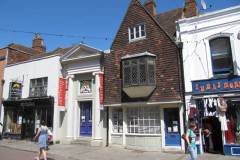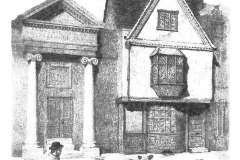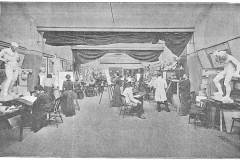St Peter’s Street
This building, named after Canterbury’s most celebrated artist Sidney Cooper, stands not far from the Westgate in St Peter’s Street (Image 1), next door to the Cooper family home (the tall gabled house to the right). Cooper funded and developed the gallery (initially as a school) in 1868 partly as a memorial to his mother Sarah (1776-1865) but also to meet the needs of poorer inhabitants who wished to study art, providing the type of help that was evidently missing during Cooper’s early years.
The school was formally opened by Cooper in March 1868 as the Sidney Cooper Gallery of Art (later the Canterbury College of Art and School of Architecture). This proved a successful decade which also brought Cooper’s second marriage (1863), his election as an Academician (1867), the appointment of his brother William Cooper as mayor for the second time (1868) and a city banquet held to honour him as its most successful artist (1870). The gallery section, 90 feet long, was built on the plots of several small houses which formerly stood by a yard known as Cackett’s Passage. The gallery entrance takes the form of an Ionic portico. Its imposing columns for such a narrow frontage did not please everyone – the architect Pugin wrote in 1870 of ‘a Grecian temple outraged in all its proportions and character’. The school was presented by Cooper to the city corporation in 1882. Mary Tourtel, later founder of the Rupert Bear series, studied here under Cooper in the 1890s (Image 2 and 3). It now forms part of Christ Church University and, following several changes of name, has since renovation in 2004 been known as the Sidney Cooper Gallery.
What to see:
- the imposing Ionic portico facing St Peter’s Street
- the house to the right where Cooper was raised and where his mother lived
- plaques commemorating both Cooper and Mary Tourtel
- the Cozens paving stone commemorating Cooper
Access: The building appears to have been closed (apart from briefly opening as a COVID-19 testing centre) since Christ Church University ended its lease in 2019.
Sources: Cantacuzino (1970); Stewart (1983); Westwood (2007)
DL



